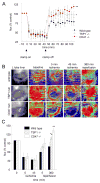Treatment of liver ischemia-reperfusion injury by limiting thrombospondin-1/CD47 signaling
- PMID: 19081017
- PMCID: PMC2635486
- DOI: 10.1016/j.surg.2008.07.009
Treatment of liver ischemia-reperfusion injury by limiting thrombospondin-1/CD47 signaling
Abstract
Background: Ischemia-reperfusion (I/R) injury remains a primary complication of transplant surgery, accounting for about 80% of liver transplant failures, and is a major source of morbidity in other pathologic conditions. Activation of endothelium and inflammatory cell recruitment are central to the initiation and promulgation of I/R injury, which can be limited by the bioactive gas nitric oxide (NO). The discovery that thrombsospondin-1 (TSP1), via CD47, limits NO signaling in vascular cells and ischemic injuries in vivo suggested that I/R injury could be another important target of this signaling pathway.
Methods: Wild-type, TSP1-null, and CD47-null mice underwent liver I/R injury. Wild-type animals were pretreated with CD47 or control antibodies before liver I/R injury. Tissue perfusion via laser Doppler imaging, serum enzymes, histology, and immunohistology were assessed.
Results: TSP1-null and CD47-null mice subjected to subtotal liver I/R injury showed improved perfusion relative to wild-type mice. Null mice subjected to liver I/R had decreased liver enzyme release and less histologic evidence of injury. Elevated TSP1 expression in liver tissue after I/R injury suggested that preventing its interaction with CD47 could be protective. Thus, pretreatment of wild-type mice using a blocking CD47 antibody improved recovery of tissue perfusion and preserved liver integrity after I/R injury.
Conclusions: Tissue survival and perfusion after liver I/R injury are limited by TSP1 and CD47. Targeting CD47 before I/R injury enhances tissue survival and perfusion in a model of liver I/R injury and suggests therapeutics for enhancing organ survival in transplantation surgery.
Figures




References
-
- Kupiec-Weglinski JW, Busuttil RW. Ischemia and reperfusion injury in liver transplantation. Transplant Proc. 2005;37(4):1653–6. - PubMed
-
- Kim YI. Ischemia-reperfusion injury of the human liver during hepatic resection. J Hepatobiliary Pancreat Surg. 2003;10(3):195–9. - PubMed
-
- Arii S, Teramoto K, Kawamura T. Current progress in the understanding of and therapeutic strategies for ischemia and reperfusion injury of the liver. J Hepatobiliary Pancreat Surg. 2003;10(3):189–94. - PubMed
-
- Fondevila C, Busuttil RW, Kupiec-Weglinski JW. Hepatic ischemia/reperfusion injury--a fresh look. Exp Mol Pathol. 2003;74(2):86–93. - PubMed
Publication types
MeSH terms
Substances
Grants and funding
LinkOut - more resources
Full Text Sources
Other Literature Sources
Research Materials
Miscellaneous

